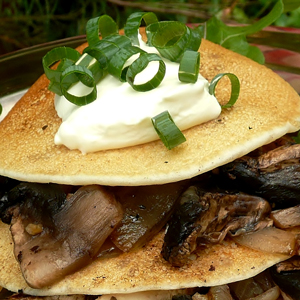 |
| Osso bucco in the pot ready to cook |
Brunch is obviously sensible in winter when the bed is warmer than the air temperature until 10 in the morning. And, as an outdoors person, my internal-clock tells me to wind down and be tired as soon as the daylight ends - I’d be a hopeless loss to humankind if I lived any further from the Equator - so the idea of cooking a main meal after dark is just not attractive. Far better to eat a slow dunch somewhere between the normal time for lunch and dinner, and then have a sunset walk or dig in the garden before retiring to the cave.
Down on the farm, a winter dunch generally involves a fire - either for a barbecue or to build a bed of coals for a camp-oven roast or stew. The fire, of course, is not just for cooking. It becomes the focal point of any gathering of family and friends. And animals.
On the day Town Frog and family came down to the farm for dunch, I had everything set out on the outside table, ready to start preparing the minute the townies arrived (with Chooky and friends getting into the act as well). The plan was to cook the rich stew of sliced veal shank and vegetables in a pot in the coals, but down came the rain.
TOWN FROG WRITES: The skies opened as we drove into the farm. So, the group decision was to continue cooking in the house. We picked up the important things - the wallaby carried the carrot - and all trouped inside. Dunch at the farm is always a bag of surprises!
Here’s what we did, and it was surprisingly simple, leaving us plenty of time to put on our raincoats and go for a long walk.
FARM-STYLE OSSO BUCCO
Easy
Time: 2 hours including oven time
Serves: 4 - 6
You will need: Heavy saucepan with lid
1. In large, heavy pot over medium heat on the stovetop place 1.5 kg cross-cut veal shank (bone in), 2 large onions, peeled and roughly chopped, and a selection of chopped seasonal vegetables (we used carrot, pumpkin, red capsicum, celery, small eggplant and a leek).
2. Add 800 gm can diced Australian tomatoes and a good handful of chives, rosemary and parsley. Simmer with the lid on 1½ - 2 hours until meat falls apart. Or oven cook 180° for 1 hour and rest in the oven for another 30 minutes before serving with pasta or rice.
Another version I like to do in the slow cooker (aka the Crock Pot) makes use of tropical herbs instead of the more traditional Italian flavours, and I use beef rather than veal to match the more robust background flavour.
OSSO BUCCO BEEF with LIME and LEMONGRASS
Easy.
Serves 4 - 6, with steamed rice.
You will need: Heavy saucepan with lid or slow cooker; cutting board and sharp knife; medium saucepan with lid or rice cooker to steam rice.
Ingredients:
1.5 - 2 kg cross-cut beef shin, bone in
2 medium onions
1 stick celery, chopped
4 large under-ripe tomatoes, roughly chopped
2 carrots, cubed
juice 2 limes
finely grated zest of 1 lime
twist of lemongrass leaves; or 1 base piece, bashed
several large sprigs coriander or Thai basil (lemon basil), shredded
½ - 1 tsp salt, or 1 tbs fish sauce
1 - 2 chopped hot red or green chillies
1 cup water
Instructions:
1. Place meat in base of pot or crock; cover with all other ingredients then add water.
2. Cook until meat falls apart. (Slow simmer for 2½ hours on stove top or 6-8 hours in slow cooker.)
3. Before serving tip the liquor from the pot into small deep bowl and lift away any fat using a deep soup ladle. Return the clear juices to the pot.
Eat heartily and enjoy!
Next: Two more easy one-pot winter warmers - pot roast veal, and shoulder pork, slow-cooked with orange and star-anise.
Written and compiled by two frogs.



























.jpg)
